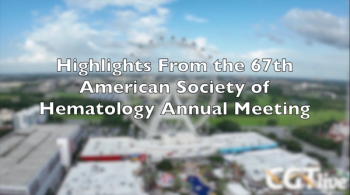
Immune Effector Cell Therapy Associated With Longer PFS After Ide-Cel Relapse in R/R MM
Differences between IEC and non-IEC post-relapse outcomes showed some significance in PFS but not in ORR.
Immune effector cell (IEC) therapies were associated with better median progression free survival (PFS) in patients with multiple myeloma (MM) than non-IEC therapies even immediately after
These findings, from a retrospective multicenter observational study, were presented by Murali Janakiram, MD, MS, Associate Professor, Department of Hematology & Hematopoietic Cell Transplantation, City of Hope, at
“With the availabilities of immune effector therapies, after failure of immune effector therapy, what is the best therapy? What are the concerns for giving back-to-back immune effector therapies? The first one is B-cell exhaustion; the second one is, postimmune effector therapy, depending on the timing of relapse, lymphopenias or cytopenias can either preclude collection or subsequent immune effector therapy; and the third one has been infections,” Janakiram said during his presentation.
Janakiram and colleagues studied data from 145 patients whose disease relapsed after ide-cel therapy. These patients, prior to receiving ide-cel, had a median age of 64 years, a median of 6 prior lines of therapy, and a 44% rate of extramedullary disease (EMD). Most patients received a fludarabine/cyclophosphamide lymphodepletion regimen and around half had a very good partial response or better at 3 (55%) and 6 months (45%). These participants had a median PFS of 150.5 days.
In first relapse, participants had a mean monoclonal (M) spike was 0.21 mg and median involved light chains was 124 mg/l. Around half of patients (57%) had EMD or paramedullary (PMD) on relapse. Predominant subsequent therapies were non-cytotoxic including selinexor or daratumumab (33%), followed by IEC therapy (29%), targeted therapy (5.6%), cyotoxic chemo (15%), and radiation therapy (4.9%).The most common IEC therapy was BCMS bispecific (65%), followed by belantamab (20%). After this round of therapy, overall response rate (ORR) was 24.9% and median PFS were 60 days.
In the second relapse post ide-cel analysis, 62 patients were included, 43% of which had EMD/PMD. Similarly to the first relapse cohort, the predominant subsequent therapy was non-cytotoxic (43%), followed by IET (30%), and cytotoxic chemo (24%). ORR was 26.9% and median PFS was 47 days.
In looking at IEC compared with non-IEC therapy, investigators found that ORR was 38% compared with 22.3% (P = .1) in first relapse and 21% compared with 29.5% (P = .69) Median PFS was 106 days compared with 66 days (P = .004) in first relapse and 66 days compared with 44 days (P = .3) in second relapse.
“The most common immune engager to be used was teclistamab and elranatamab. If talquetamab was more commonly used, would the PFS be better in the IEC arm? A second limitation is, this is a study of mainly academic centers, so academic centers and patients who have access to IEC therapy in the first relapse setting (mostly clinical and commercial). The last one is that non-IEC therapies are very limited and available only in clinical trials,” Janakiram said.
REFERENCE
Janakiram M, Khouri J, Castaneda O, et al. Immune Engager Therapies Are Associated with Better Outcomes in Post Ide-Cel Relapse in MM- an Analysis of the US MM Immunotherapy Consortium Database. Presented at: 2024 Tandem Meetings, February 21-24, San Antonio, Texas. Abstract #39
Newsletter
Stay at the forefront of cutting-edge science with CGT—your direct line to expert insights, breakthrough data, and real-time coverage of the latest advancements in cell and gene therapy.































